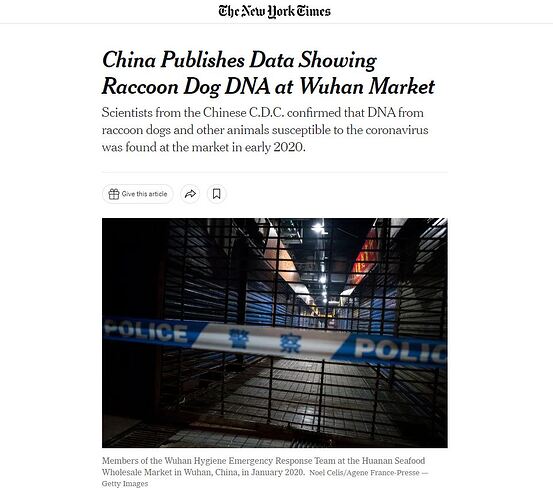-
中国政府的科学家发表了一份关于武汉一个市场的研究报告,承认在病毒出现的前后,那里有易受冠状病毒影响的动物。然而,目前仍不清楚大流行是如何开始的。这项研究最初是在2月份发布的,但是为同行评议的杂志增加了更多的基因序列数据。
-
研究该大流行病起源的国际科学家发现,冠状病毒检测呈阳性的样本含有来自动物的遗传物质,包括与浣熊犬的匹配。这并不能证明浣熊犬被感染或动物将病毒传染给人,但它确定了浣熊犬在与病毒相同的地方留下了它们的遗传特征。
-
国际团队的分析似乎加快了中国科学家研究报告的发布速度。这篇文章被接受发表,仍然是一个早期版本,没有经过编辑。与中国疾控中心有关的几位作者没有对评论请求作出回应。
-
在2022年2月的第一版文章中,中国作者没有提到在市场的棉签中发现任何来自浣熊犬的遗传物质。
-
在一年多以后的周三版本中,他们写道,这项研究 “证实了浣熊犬的存在”,以及市场上其他易受冠状病毒感染的动物。
-
许多科学家认为,现有的证据表明,这些动物可能是病毒的中间宿主,而病毒可能起源于蝙蝠,但这些证据并没有完全排除人们在市场上将病毒给动物的情况。
-
中国作者强调了新研究中的不确定性,并提出了病毒可能通过冷冻食品的包装被运到武汉市场的观点。
-
该研究还包括一些不太可能的发现,如来自大熊猫、黑猩猩和鼹鼠的遗传物质,这些物质可能在实验室中被错误地归类或污染了。
-
该杂志的一位发言人指出,作者包括一个警告,即在市场上发现的物种清单 “不是确定的”,需要更多的分析。
-
对于上个月首次报告在Covid阳性拭子中发现浣熊犬迹象的国际科学家来说,《自然》杂志的最新研究对中国团队用于分析序列的方法留下了许多重要的问题没有回答。
-
尽管如此,该出版物还是提供了关键的新数据,包括从市场上每个摊位上提取的棉签数量,这使得国际团队能够确认一个重要的发现–从市场上销售野生动物的角落提取的棉签更有可能对病毒检测呈阳性。
-
约翰霍普金斯大学的前博士后研究员和计算生物学家Alexander Crits-Christoph说,这组数据令人印象极为深刻,其重要性相当高,在科学记录中发表是一件好事。
-
Chinese government scientists published a study about a market in Wuhan, acknowledging that animals susceptible to the coronavirus were there around the time the virus emerged. However, it remains unclear how the pandemic began. The study was originally posted in February but more genetic sequence data was added for a peer-reviewed journal.
-
International scientists studying the origins of the pandemic found that samples testing positive for the coronavirus contained genetic material from animals, including a match for the raccoon dog. This did not prove that a raccoon dog was infected or that animals gave the virus to people, but it established that raccoon dogs left their genetic signatures in the same place as the virus.
-
The international team’s analysis appears to have sped up the release of the Chinese scientists’ study. The article was accepted for publication and is still an early version which has not been edited. Several authors affiliated with the Chinese C.D.C. did not respond to requests for comment.
-
In their first version of the article from February 2022, the Chinese authors did not mention finding any genetic material from raccoon dogs in the market swabs.
-
In Wednesday’s version a little more than a year later, they wrote that the study “confirmed the existence of raccoon dogs” and other animals susceptible to the coronavirus at the market.
-
Many scientists believe that the existing evidence points to those animals likely acting as intermediate hosts for the virus, which probably originated in bats, but the evidence does not completely rule out a scenario in which people gave the virus to animals at the market.
-
The Chinese authors stressed the uncertainty in the new study and raised the notion that the virus could have been ferried to the Wuhan market on packages of frozen food.
-
The study also included some unlikely findings, such as genetic material from pandas, chimpanzees and mole-rats, which could have been incorrectly categorized or contaminated in the lab.
-
A spokesman for the journal noted that the authors included a caveat that the list of species identified at the market was “not definitive” and more analysis was required.
-
For the international scientists who had first reported finding signs of raccoon dogs in the Covid-positive swabs last month, the latest Nature study left a number of important questions unanswered about the methods used by the Chinese team to analyze the sequences.
-
Still, the publication supplied critical new data, including the number of swabs taken from each stall in the market, which allowed the international team to confirm an important finding - swabs taken from a corner of the market selling wild animals were more likely to test positive for the virus.
-
Alexander Crits-Christoph, a former postdoctoral researcher and computational biologist at Johns Hopkins University, said that the data set was extremely impressive and its importance was quite high, and that it was a good thing it had been published in the scientific record.
